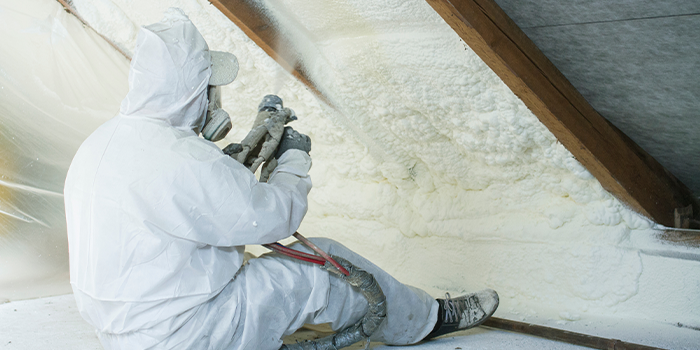What’s in That Stuff?


SPRAY FOAM MAGAZINE – Have you ever wondered what’s in those A and B-side drums that makes the liquid turn into the rigid, airtight and highly insulative materials you can apply to just about anything? What causes it to turn from liquid to foam? Have you noticed that roofing foam takes longer to expand than wall foam or even open-cell foam? How and why? In this article, we’re going to ask the dumb questions you’ve always wanted to know but didn’t want to ask.
I’m sure most of you have received training and a basic instruction in polyurethane foam chemistry, but mostly you’ve been taught how to run your equipment, setting temperatures, watching pressures, knowing when you can spray and onto what surfaces. You have been trained in how to troubleshoot your equipment if it’s not running right and, maybe most importantly, have learned the hard way not to put the B-side pump into the isocyanate drum or visa versa! We’re not going to cover that. We’re going to get nerdy and talk about chemistry. We’re going to dive a little deeper into the spray foam chemical formulations, what purpose they serve and how each formulation is different.
Understanding the basics
As you well know, spray polyurethane foam insulation (SPF) is a popular choice for homeowners and builders alike, owing to its excellent insulating properties and versatility. To truly appreciate its efficacy, it is essential to delve into the chemical composition that makes SPF a formidable insulating material. SPF is a composite material that is primarily composed of two main components: polyol resin and isocyanate. When these two liquid components are combined, a chemical reaction occurs, leading to the formation of a rigid foam that expands, adheres to surfaces, and ultimately creates an effective thermal barrier.
Polyurethane chemistry was first developed by Dr. Otto Bayer in 1937 and it wasn’t until the 50s that it reached industrial scale and was established in the market (De Sosa et al., 2021). Take note, spray polyurethane foam is only one type of polyurethane. Polyurethane chemistry is used to make all sorts of plastic like materials from bowling balls to liquid roof membranes. The chemistry is extremely customizable which makes it a very versatile chemistry.
In its simplest form, polyurethane chemistry is the combination of isocyanates and polyols. This is the combination of what is commonly called the A-side (isocyanates) and B-side (polyol resin). If you’ve had any sort of chemistry, you’ll remember chemical reactions are like math equations where products are added together to make something new. Following is the “mathematical” formula or chemical reaction that forms polyurethane.
In this formula below, the N=C=O in the isocyanate reacts with the hydroxyl groups (OH) in the polyol (diol) and they connect together and form a very long chain through a polyurethane polymerization. This reaction forms a polymer chain, creating a three-dimensional network of interconnected molecules. This long polymer chain forms the rigid plastic you find in spray foam.
In addition to creating polyurethane, the chemical reaction is thermodynamic or gives off heat, a significant amount of heat. In the case of polyurethane, the heat can be enough to cause a fire if not handled correctly. When controlled properly, by following your amount of catalyst takes the skill of a polyurethane foam chemist with years of experience.
Surfactants
Surfactants have many uses, but one of their main functions is to control what happens to the cells or bubbles once the blowing agent is activated. The amount and type of surfactant will either make the cells open or remain closed after the reaction is complete. They also help regulate the size of the cells.
Flame Retardants
Flame retardants are a special type of chemical that can react with or remain part of the finished foam product. There are many different types of flame retardants and many can be used at one time in the formulation. Much like the name suggests, flame retardants help control the flammability properties of SPF so they can safely insulate a building and pass necessary life-safety building codes.
Types of Spray Polyurethane Foam
Open-cell SPF: Open-cell SPF is characterized by a structure where the cells are not completely encapsulated. The open structure allows air and moisture to penetrate, making it a breathable material. The chemical composition of open-cell SPF typically involves a higher percentage of water, which contributes to its lower density and softer texture.
Closed-cell SPF: In contrast, closed-cell SPF has cells that are completely encapsulated, creating a more rigid structure and dense foam. The closed-cell structure captures the highly thermally resistant fluorocarbon gas giving it a higher R-value per inch and much more resistance to moisture infiltration.
Conclusion
Polyurethane is an extremely versatile and complex set of chemistry that allows our industry to manufacture highly specialized and high performing insulation materials. Each manufacturer employs skilled polyurethane chemists to develop and control the type and amount of each formulation ingredient to manufacture their unique product that meets stringent customer and building code requirements. Understanding the chemical makeup of spray polyurethane foam allows us to appreciate its role in enhancing energy efficiency and creating more comfortable living spaces while being mindful of safety and environmental considerations.
For use by SprayFoamMagazine.com & Spray Foam Magazine
Disqus website name not provided.









































